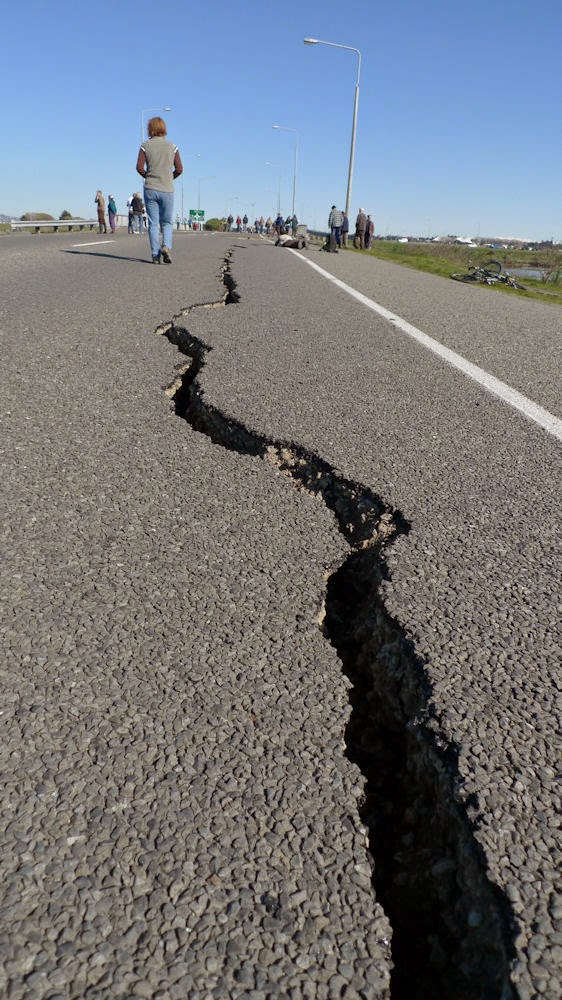
To understand earthquakes, scientists have hatched an audacious plan – go straight to the source.
That means drilling miles-deep into the earth, directly through faults where two plates of the earth’s crust come into contact.
Geologists at the University of Wisconsin-Madison are doing just that, as part of two experiments located at dangerous faults in New Zealand and Japan – faults that could rupture at any moment, causing massive earthquakes.
“These are the natural disasters that kill the most people on the planet. So we need to know as well as we can how they work and whether there are ways to mitigate their effects by early warning or detection,” said Harold Tobin, a professor in the department of geoscience at UW-Madison.
To understand the processes that trigger such massive quakes, the scientists will take samples of rock from the faults they drill, record the conditions in the borehole and, if they’re lucky, catch a quake in action.
Earthquakes are some of the most destructive and deadly natural disasters on the planet. They also are some of the least predictable. Scientists can say how likely a fault is to experience a quake, but only over the span of decades – not very helpful for people living in the area who need to take cover in the moments before.
Scientists don’t know how – or even if – it might be possible to predict earthquakes. Part of the problem is they know so little about how earthquakes start. The phenomenon begins deep below the surface of the earth, inaccessible to researchers.
Typically, earthquakes are studied by measuring the seismic waves that emanate from tremors within the earth. This information is useful, but it’s indirect. It’s sort of like trying to figure out what’s inside your Christmas present by shaking the box around – you’d know much more if you could unwrap it and look directly at what was inside.
This is why the scientists want to drill down to the fault. They will take cores as they drill, bringing up intact samples of rock in order to study their properties. And they will place instruments in the borehole to measure seismic tremors and other important characteristics of the fault zone, like the pressure, temperature, and stresses and strains on the rocks, as well as properties of groundwater in the area.
“If we want to understand earthquakes, it’s one of the few kind of direct ways we can get evidence about what faults are like,” said Clifford Thurber, a professor in the department of geoscience at UW-Madison.
Thurber and Tobin are part of an international group of scientists working on the Deep Fault Drilling Project, an experiment studying the Alpine Fault in New Zealand.
Fault due for quake
This fault has lain dormant since 1717, and it typically produces a major quake every 300 or 400 years. Scientists therefore think the fault is due, estimating a 28 percent chance of a quake in the next 50 years. Beginning in October, experimenters will drill nearly a mile deep into the Alpine Fault.
Drilling such holes, however, is no easy task – especially for faults that are underwater, as many of the most dangerous, tsunami-generating faults are.
As co-chief scientist of the Nankai Trough Seismogenic Zone Experiment (NanTroSEIZE) in Japan, Tobin spent seven weeks at sea last winter on a scientific drilling ship called the Chikyu, drilling into the Nankai Fault off the coast of southern Japan.
At times braving harsh winds and waves as high as 30 feet, Tobin and his fellow scientists took round-the-clock shifts analyzing the data and cores of rock that came out of the borehole. The hole is currently more than halfway to its planned depth of three miles below the seabed.
Instruments will remain in the boreholes of both experiments for decades, quietly collecting data, waiting for a quake that could strike at any time.
The UW researchers also were involved in an earlier experiment, the San Andreas Fault Observatory at Depth (SAFOD), completed in 2007. Scientists drilled a two-mile-deep hole that pierced the infamous San Andreas Fault in California.
The experiment recovered some of the first samples of rock from a fault at the depth where small earthquakes can originate.
However, scientists encountered many setbacks. Drilling was more expensive than expected, due to rising oil prices. And instruments placed in the borehole failed shortly after they were installed, due to the corrosive gases, crushing pressures and high temperatures they encountered at that depth.
“The whole thing is just like a cauldron down there,” Thurber said.
The lessons scientists learned through their struggles with SAFOD will be applied to the experiments in New Zealand and Japan.
These experiments won’t quite reach the depth where major quakes are initiated, but they will gain valuable information about how faults behave close to the source, and how earthquakes travel along the fault when it ruptures.
“We’re seeing rocks much closer to what they are like down where earthquakes do their thing,” Thurber said.
Note : The above story is based on materials provided by ©2014 Milwaukee Journal Sentinel
Distributed by MCT Information Services










